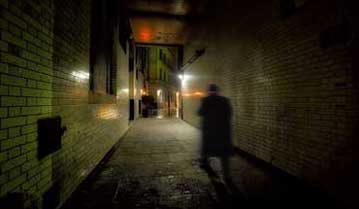THE CITY OF LONDON'S MOST HAUNTED PUB
The Viaduct Tavern stands opposite the Old Bailey - or the Central Criminal Court to give the building its correct title.
Over the years the tavern has been the focus of a significant amount of paranormal activity, so much so that it is probably one of the most haunted pubs - if not the most haunted pub - in the City of London.
THE VIADUCT TAVERN'S HISTORY
But, before we get to the hauntings, it is important that we learn something of the history of the building, as, knowing about its past, and of the people who have been associated with it over the years, might help us establish exactly whose is the ghost that haunts the premises.
However, as is often the case with haunted properties, there has been a certain amount of myth making about the Viaduct Tavern's past, and one or two of the colourful tales that are presented as historical facts about it are as tall as the building itself!
So, let's take a detailed look at the pub's past.
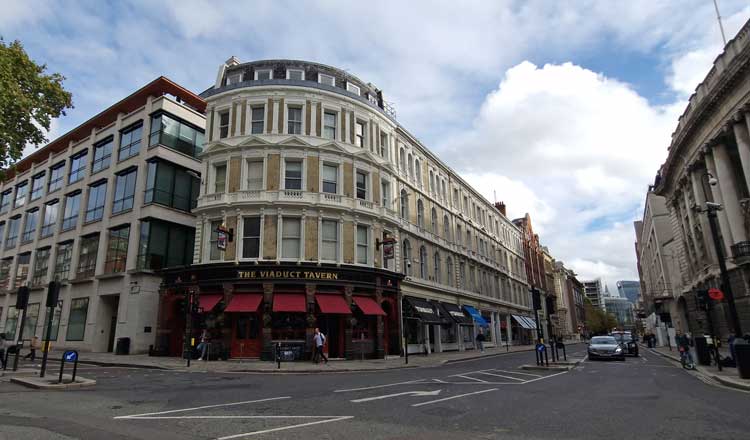
DUNGEONS AND DATES
According to many guide books, the pub was built in 1869, and its cellars contain several surviving cells from Newgate Prison, which used to stand across the road from the tavern on the site that is now occupied by the Old Bailey.
Much as it is a wonderful flight of fancy to imagine long ago felons enduring their incarcerations in the pub's dark depths, it must, sadly, remain nothing more than a flight of fancy, as neither claim is actually true.
BUILT BETWEEN 1872 AND 1875
The pub was, in fact, built between 1872 and 1875, and was named for the Holborn Viaduct, a thoroughfare that had been constructed between 1863 and 1869 as part of the Holborn Valley Improvements - a scheme which swept away one of London's most notorious slums, the Field Lane and Saffron Hill Rookery, which was so infamous for villainy that Charles Dickens saw fit to place Fagin's lair there in Oliver Twist.
PREVIOUS BUILDINGS ON THE SITE
Prior to the Viaduct Tavern's construction, the site on which it stands had enjoyed a fairly uneventful existence that most certainly didn't include the keeping of any prisoners in its basement - and it was more noted for what went on around it rather than for what actually happened on it.
THE SITE OF NEWGATE PRISON
The plot on the opposite site of Newgate Street, where the Old Bailey now stands, was, from the 12th century to 1904, the site of Newgate Prison.
It was in the square outside the prison that public executions were carried out from the late 18th century until 1868, when the spectacle of hundreds of people cramming together in an unsightly scrum, vying with one another to get a good view of felons dying on the scaffold, was deemed inappropriate for a civilized and aspirational society, and the hangings were thereafter moved inside the prison.
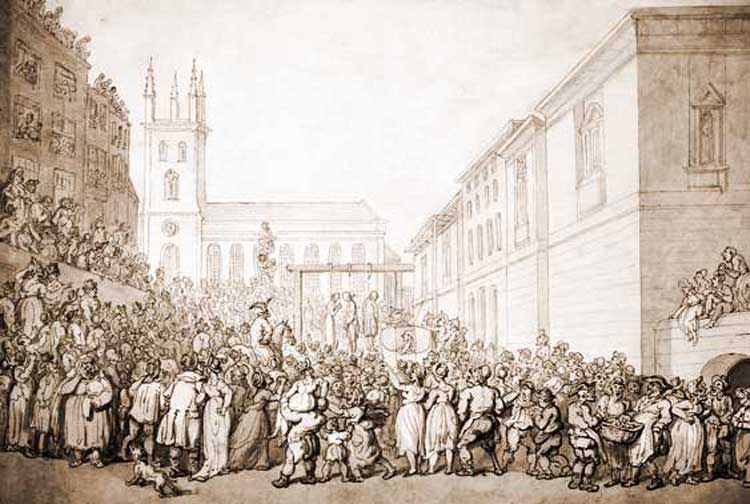
HANGING BREAKFASTS
The Viaduct, therefore, missed out on one of the more lucrative benefits of the public executions, the offering of so-called "hanging breakfasts", for which the local hostelries would let out their upper floors to enable wealthy patrons a much better vantage point from which to watch the executions, whilst they tucked into hearty breakfasts which they washed down with copious amounts of ale or other alcoholic beverages of their choice.
Newgate Prison was demolished in 1904, and the Central Criminal Court was then built on its site.
THE GILTSPUR STREET COMPTER
From 1791 to 1854 the site on the Giltspur Street side of the pub was occupied by the Giltspur Street Compter, a small prison that was mainly used to hold debtors, and the few illustrations we have of the site on which the Viaduct Tavern now stands show it in relation to the Compter, as in this view of it dating from 1840.
The prison closed in 1853 and was demolished the following year, as is recorded by a blue plaque that adorns a wall of what is now Bank of America Merrill Lynch next door, and from whose offices a large percentage of the pub's patrons are now drawn.
It was in the square outside the prison that public executions were carried out from the late 18th century until 1868, when the spectacle of hundreds of people cramming together in an unsightly scrum, vying with one another to get a good view of felons dying on the scaffold, was deemed inappropriate for a civilized and aspirational society, and the hangings were thereafter moved inside the prison.
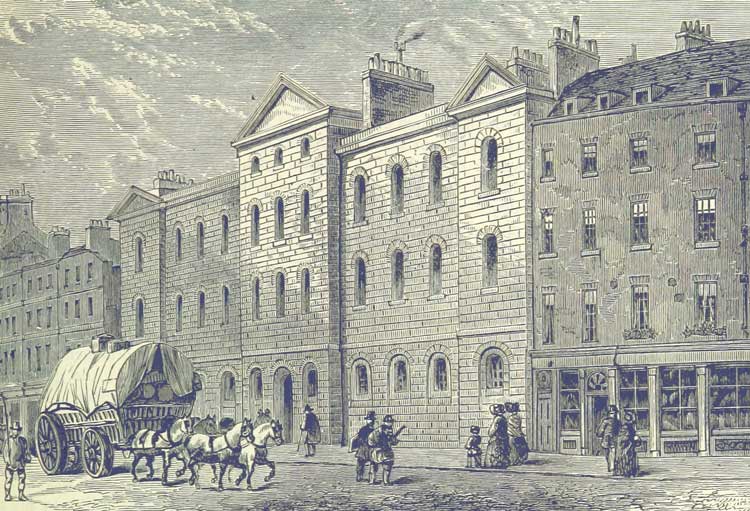
THE BLASPHEMOUS JOHN TRUST
We get a clearer idea of what went on on the site of the Viaduct Tavern from the 19th century newspapers.
In 1823, a printer's shop, operated by Joseph William Trust, stood here.
In the November of that year, he found himself moving across the road to Newgate Prison having been found guilty of publishing a, "blasphemous libel on the Christian religion and the Holy Scriptures", a conviction that reduced him to penury and forced him to give up the premises.
AN INSTITUTION MOVES IN
By 1825, the grandly named London Friendly Institution Of Mechanics, Atrizans And Others, was operating from 126 Newgate Street.
The organisation had been, "Established and Enrolled By Authority of Parliament:- To promote the welfare, independence and comfort of the labouring classes, by enabling them, at small expense, to provide for relief, with medical attendance and medicines during sickness; Sums of money at death, Endowments for children and Annuities for Life.'
PUBLISHERS AND SHOEMAKERS
Their tenure lasted until 1838, when publishers S. Cornish and Co., began trading from the premises, and by 1856, William Rait, also a printer, had taken over the building.
He was followed by J. P. Lloyd, who, in 1862, was inviting the "Catholic Clergy, Nobility, Gentry, and Public in General" to visit his establishment here, where, he assured them, they would find, "the best and cheapest home made or foreign boots and shoes as well as every variety of goods, and at the lowest prices consistent with a really good durable article."
NEWGATE STREET TO BE WIDENED
Lloyd had moved out by 1867,by which year Mr Francis, Public House broker, had established himself here, and by 1870 T. B. Cameron and Co, suppliers of the finest old brandies, and importers of wines, spirits and champagne.
By this time it had been decided that Newgate Street was far too narrow for the amount of traffic that was using it as a result of the construction of the Holborn Viaduct; and, in 1871, it was announced that the buildings on the north side of Newgate Street, at its junctions with Giltspur Street, were to be demolished, in order to widen the road.
Since no further adverts appear for T. B. Cameron and Co. or for any other business at 126 Newgate Street after Wednesday the 3rd of January 1872, it is safe to assume that it was around this time that the buildings were demolished to be re-developed as what would become the Viaduct Tavern.
ROMAN REMAINS FOUND
As the workmen began digging the foundations of the new building, they hit a major problem which The Journal of the British Archaeological Association brought to the attention of the Association's members:-
"The most western of the houses abutting upon Giltspur Street, on the northern side, and at the extreme western end of Newgate Street, having recently been demolished for widening, the work of rebuilding on the lessened side has been commenced.
In clearing the ground for this, the progress of the workmen was much impeded by the existence of a massive wall which was met with a few feet below the present level of Newgate Street, and so solid in its construction that it could only be removed by wedges and crowbars."
NOT IMPORTANT ENOUGH TO PRESERVE
At the time, antiquarians hailed the find as one of the most significant and important Roman discoveries in London.
However, the remains weren't considered significant or important enough to actually preserve, and, by 1875, the Viaduct Tavern had risen on the site.
THE VIADUCT TAVERN
It boasted a curved facade that was intended to make it stand out and thus attract the attention of passing trade.
There were, and still are, three doors, far too many for the tiny bar that actually greets customers today, but which reflect the fact that the hostelry was divided into three compartments consisting of a public bar, a private bar and a saloon bar, each one catering to a different class of clientele, and each one entered through its own dedicated door.
The horse-shoe shape of the bar enabled the staff to serve and keep an eye on the activities of the patrons in each compartment, and the ornate box at the rear of the pub was where the manager would sit to oversee the proceedings.
AN 1889 COURT CASE
Judging by a court case that was heard in the Queen's Bench Division of the High Court on the 15th of May 1889, the pub was a profitable establishment.
Mr Lake - who had purchased the tavern from Mr Hablett for the princely sum of £24,000 - sought £6600 in damages on the grounds that Hablett had assured him that the takings were £800 a month, whereas his takings since acquiring the pub had only been £740 a month.
Hablett denied misrepresentation, arguing that, if the takings were less than he had stated, it was on account of Mr. Lake's poor management.
The jury disagreed and found in Mr. Lake's favour, and the judge ordered Hablett to pay £2000 in damages.
A BRICK THROUGH THE WINDOW
Thereafter, the pub was mentioned every so often in the newspapers over the course of the next decade.
In April 1891, Sarah Grover, a twenty-five-year-old laundress from Dudley, found herself in court at the Mansion House after she threw a brick through one of the pub's plate glass windows, which was valued at £4.
When charged, she said that she had carried the brick about with her for some time and had intended to break the window, albeit the Lord Mayor, who remanded her in custody, appears not to have thought to ask her why she had wanted to throw a brick through the pub's window.
THE COST OF TWO MINUTES
In October 1899, Florence Wane, aged 66, a cook from Walworth in South London, sued the then proprietors of the establishment Messrs. Levy and Franks for twelve shillings, which she claimed she was owed as wages for having worked for them for a week.
She explained to the presiding Magistrate at the City of London Court, Commissioner Kerr, that she had only been in the defendants service for one week, and that, when she commenced her employment she had been told that she should have twelve shillings a week plus board and lodging.
However, she found the work too hard, and it was agreed that, at the end of the week, she could go and seek a less demanding situation elsewhere.
But, when she returned that night, the defendants refused to let her in, telling her, through their manager, that since it was two minutes past eleven - two minutes after the house had officially closed - she could not enter, as they never opened the doors after closing time.
Commissioner Kerr told her that, in being two minutes late, she had disobeyed orders, and he rejected her claim.
"Then I am to do a week's work for nothing, just because I was two minutes late?", an unimpressed Florence Wane lamented on hearing the verdict.
"Yes, I am afraid so," responded Commissioner Kerr, "I must find for the defendants."
Reporting on the case in its edition of Saturday the 7th of October, The Pall Mall Gazette opined that:- "The decision is probably good law, but it sounds harsh."
THE VIADUCT TAVERN REFURBISHED
The Viaduct Tavern's current interior dates from the mid 1890s, a time when London pubs were enjoying a boom, and landlords were less like the publicans of bygone times, and more like property speculators who would buy hostelries, refurbish them, and then sell them after a few years at a considerable profit.
This 1890s refurbishment saw the pub acquire its current interior decor.
And what a splendid decor it is.
Customers can still marvel at the ornate plaster ceiling; be dazzled by an abundance of brilliant cut-glass; shiver at the stern plaster faces that gaze down from on high; and admire the three allegorical paintings on canvass of vaguely classical females, each a depiction of the statues that adorn the nearby Holborn Viaduct.
One of the ladies in the central panel has an unsightly gash on her back, reputedly the result of a bayonet thrust by a drunken off duty soldier during a scuffle inside the pub in the First World War.
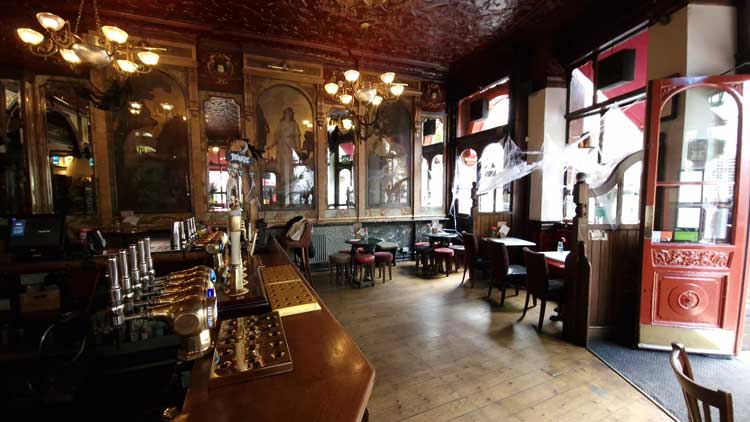
THE GHOST OF THE VIADUCT TAVERN
Claims that the pub is haunted began to circulate in the late 1970s, when its clientele consisted of a mixture of postmen who worked in the neighbouring King Edward Building sorting office, until its closure in the mid 1990s, and an assortment of crime correspondents, witnesses, spectators, families of the accused - and occasionally the accused themselves - from the Old Bailey opposite.
A SUNDAY AFTERNOON ENCOUNTER
In 1981, the then landlord's daughter had been left in charge one Sunday morning in the days when pubs were required by law to close of an afternoon.
She had locked up after the morning session, had gone upstairs, and was sitting on the sofa reading a newspaper when, suddenly, she heard footsteps come stomping up the stairs.
Suddenly, the door flew open, the paper was snatched from her hand, thrown to the floor, the door slammed shut, and the footsteps went back down the stairs.
She searched the pub, but could find no sign of anybody or anything.
THE DOG AND THE GHOST
In 1985 a new landlord took over the pub's licence.
He had a German Shepherd - a dog which, to say the least, didn't take kindly to strangers entering the premises after closing time, or uninvited.
However, that dog - whose bite was certainly much worse than its bark - would often sit opposite the cellar door, its hackles raised, growling at something or someone it could apparently see in the cellar doorway, but which remained invisible to human occupants of the pub.
THE GHOST BECOMES KNOWN AS FRED
Throughout the 1990s, the ghost of the Viaduct Tavern grew ever more mischievous, and would do things like drink peoples drinks when they weren't looking, switch the lights on or off at all times of the day or night, and flush the toilet in the ladies toilet at the most inopportune of moments.
But, as so often happens when people have a resident spook on their premises, successive landlords and bar staff grew quite affectionate towards their ghost, and they gave him a name - and that name was "Fred."
Thereafter, whenever an angry custom came up to complain:- "Look I put my drink down, I turned round, turned back and my drink was gone", they'd be told = "sorry, it's Fred, he does this, please have another one on us."
An irate lady might come stomping up from the toilets in a state of disarray to complain that the toilet had flushed whilst she was sitting on it. She'd be told:- "Our apologies, it's Fred, he does these things, please have a drink on the house.'
THE HAUNTING OF THE CELLAR
The cellar, in which much of the ghostly activity seems to occur, possesses a truly spooky ambience, and your eyes can play strange tricks on you as you gaze into its darker recesses.
The rumbling of tube trains passing deep beneath it can be decidedly unsettling, and the knowledge that you are standing in Fred's undisputed domain can elicit cold shivers, even on the hottest of days.
Yeast clings to its walls, shadows dance across its crumbling brickwork. In some places the paint peels from the walls, in others the walls peel from the paint.
Information boards reveal intriguing snippets of information about the two prisons that used to stand hereabouts, and it isn't long before the realisation dawns that this is not a place at which you would wish to linger for any longer than is necessary.
THE MANAGER'S CHILLING EXPERIENCE
In 1996, a manager was tidying the cellar one Saturday morning, when the door suddenly slammed shut and the lights went out.
Feeling his way to the doors, he found that, no matter how hard he pushed, he just could not open them.
Fortunately, his wife heard his cries for help and she came downstairs to investigate.
She found that the doors, which her partner could not open from the inside, were unlocked and were easily opened from the outside.
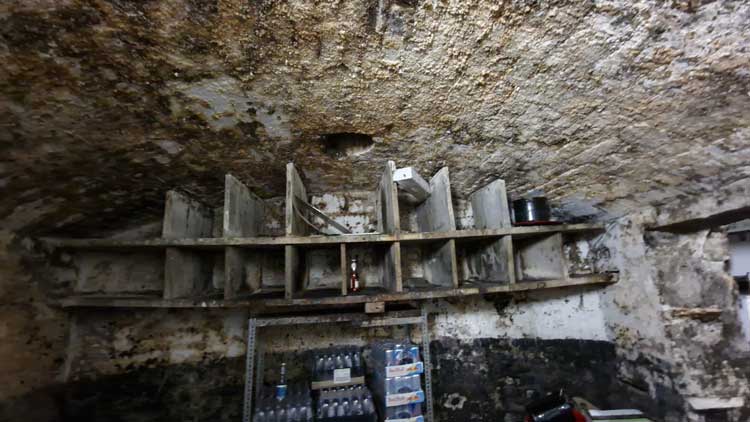
A TELEVISION MEDIUM MAKES A DISCOVERY
In 1997, a London news station decided that it would make an interesting item on their evening Halloween programme if they took a medium to a haunted location to see if the medium could make contact with the ghosts.
Several of the crew had, at one time or another, covered trials at the Old Bailey opposite, had refreshed themselves in the Viaduct Tavern, and were, therefore, au fait with its ghostly goings-on.
So the Viaduct Tavern was the location that was chosen for the Halloween special.
When their medium arrived, the first thing she did was walk up to the landlord and tell him in no uncertain terms:- "You have a Scottish gentleman here called Robert, who would be much obliged if you would stop calling him Fred!"
A SHOCK FOR THE ELECTRICIANS
In May 1999, two electricians, who were working in one of the pubs upstairs rooms, also attracted the ghost's unwelcome attentions.
They had rolled the carpet up and were taking up the floorboards, when one of them felt a tap on his shoulder.
Thinking that it was his workmate, he turned round, but found that his colleague was on the other side of the room.
Believing that he'd imagined it he went back to work.
But, after a few minutes, he felt another tap on his shoulder.
Standing up, he went over to his friend to ask if he was playing a prank, but the man denied tapping him on the shoulder.
Turning to resume his chores, both of them were astonished when the heavy carpet, that lay rolled up by the window, was lifted into the air and dropped heavily onto the floor.
That was enough for them, they hurried from the room, and would only return to work after reassurances from the manager that "Fred" was perfectly harmless.
THE GHOST STILL ACTIVE
Today, Fred is as active as ever, and strange things continue to happen inside the pub.
The temperature can drop suddenly for no apparent reason, inexplicable noises are, from time to time, heard emanating from the cellar, and the hand driers in the toilets can switch on without warning - a phenomenon that the management have seen fit to warn people about on a board in the gents toilet.
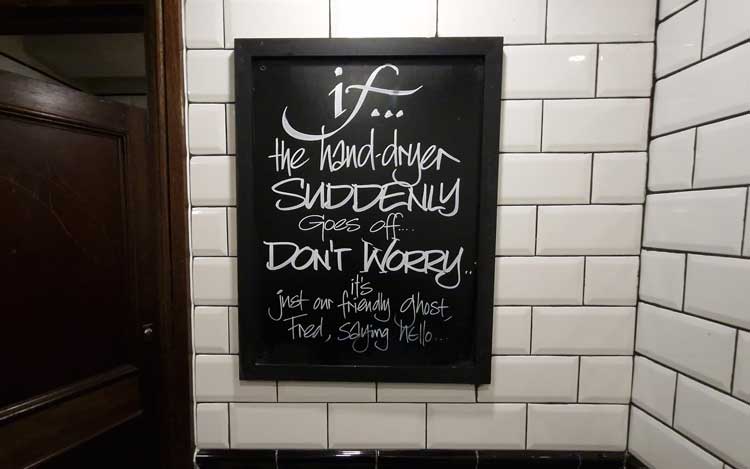
THE VIADUCT TAVERN'S HAUNTED HOSPITALITY
Paranormal activity aside, the Viaduct Tavern is a fantastic place to visit, offering as it does delightful decor, a friendly atmosphere and an historic location.
But add to these the opportunity to make the acquaintance of Fred, the oldest resident to now inhabit the premises, and - well, let's just say what reason is there not to visit a pub that can offer its clients some good old fashioned haunted hospitality.


